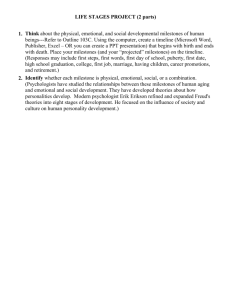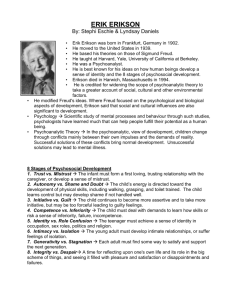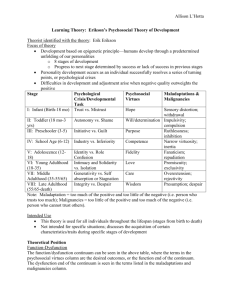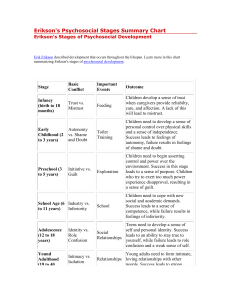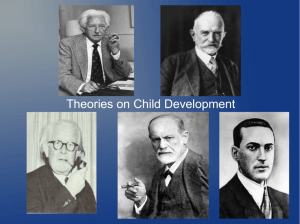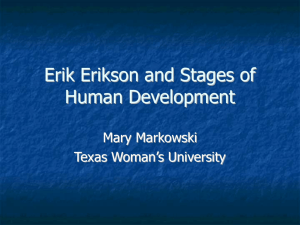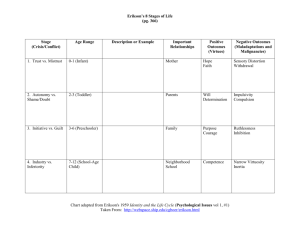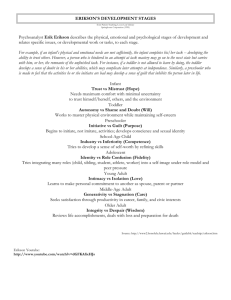Erik Erikson's Theory of Psychosocial Development
advertisement
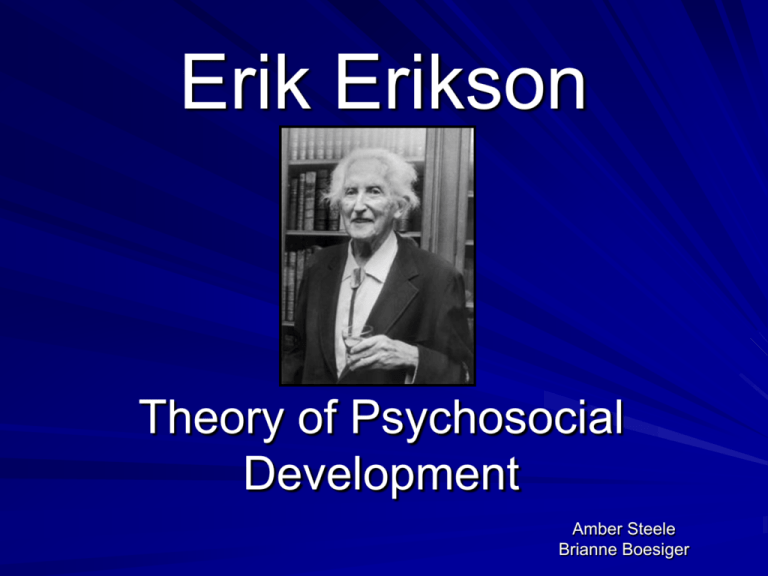
Erik Erikson Theory of Psychosocial Development Amber Steele Brianne Boesiger Erik Erikson 1902 - 1994 Timeline- The Early Years 1902- Born in Frankfurt, Germany 1911- Is adopted by stepfather Theodor Homburger 1919- Begins travels throughout Europe Timeline- Young Adulthood 1927- Becomes teacher at Hietzing School in Vienna 1928- Studies child psychology with Anna Freud 1930- Marries Joan Serson, a dance teacher at the school Timeline- Career 1933- Emigrates to US 1939- Becomes US citizen 1960- Begins teaching at Harvard Erikson’s Psychosocial Theory 8 Stages of man Each stage includes: Significant relationship Psychosocial crisis Potential positive or negative outcome Disagreement on ages of stages, even among contemporaries The Eight Stages Stage 1- Infancy - 0-1½ years - Maternal persons - Trust vs. Mistrust + Hope, drive - Sensory distortion, withdrawal Stage 2- Early Childhood - 1- 3 years - Parental persons - Autonomy vs. Shame and Doubt + Will power, self control - Impulsivity, compulsivity The Eight Stages Stage 3- Pre-school - 3-6 years - Family - Initiative vs. Guilt + Purpose, direction - Ruthless, inhibition Stage 4- School child - 6-12 years - Neighborhood, school, family - Industry vs. inferiority + Competence, initiation - Narrow character, low motivation The Eight Stages Stage 5- Adolescent - 12-20 years - Peer group - Identity vs. role confusion + Self certainty, fidelity - Withdrawal, fanaticism “Who am I?” – Experimentation of different roles to find one most suitable or comfortable – Assimilating morals learned as a child to ethnics needed as adults (ChildStudy.net) The Eight Stages Stage 6- Young adulthood - Friends, co-workers, sexual partners - Intimacy vs. isolation Stage 7- Middle adulthood - Family (partner, children), community - Generosity vs. self absorption Stage 8- Late adulthood - Society, the world community - Integrity vs. despair Application of Erikson’s Theory Stage 4 (school age) – Hands on projects – Increasing influence Encourage sense of accomplishment and self worth Finding the natural talents of individuals Stressing the importance of individual success Application of Erikson’s Theory Stage 5 (adolescence) – Seek leadership/ inspiration – Understanding of distractions Not belittling adolescence ideals – Experimentation requires acceptance – Sense of sameness Encouragement of natural individual talents Critics Doubted his academic integrity Questioned the stage theory as opposed to continuous development Said that his theory is more applicable to boys than to girls Complain that more attention is paid to infancy and childhood than to adult life Questions What about those adults who rediscover themselves and develop a different understanding of their lives due to life's changes and experiences? Is it possible for an individual to change throughout life? How can his theory be applicable to the changing environment of today? References http://www.alanchapman.com/erik_erikson_psychosocial_theory.htm http://www.childdevelopmentinfo.com/development/erickson.shtml http://childstudy.net/erikson.php http://webspace.ship.edu/cgboer/erikson.html http://www.nndb.com/people/151/000097857/ http://www.nytimes.com/books/99/08/22/specials/erikson-obit.html http://www.phillwebb.net/History/TwentiethCentury/Continental/Psychoanalysis/Erikson/Erickson.htm http://www.nytimes.com/books/99/08/22/specials/erikson.html http://education.stateuniversity.com/pages/1960/Erikson-Erik-1902-1994.html Educational Psychology: Theory and Practice
